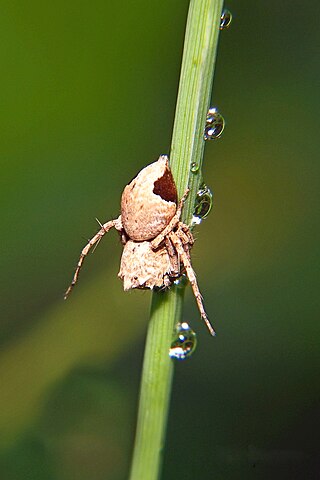
Agobardus is a genus of jumping spiders that was first described by Eugen von Keyserling in 1885.

Anasaitis is a genus of jumping spiders that was first described by E. B. Bryant in 1950. The name is derived from the salticid genus Saitis.
Antillattus is a genus of Caribbean jumping spiders that was first described by E. B. Bryant in 1943. The name is a combination of "Antilles" and the common ending for salticid genera -attus.

Compsodecta is a genus of Caribbean jumping spiders that was first described by Eugène Louis Simon in 1903.
Descanso is a genus of jumping spiders that was first described by George and Elizabeth Peckham in 1892. The name is derived from Spanish descanso, meaning "resting place ", from the verb descansar "to rest."
Parathiodina is a monotypic genus of jumping spiders containing the single species, Parathiodina compta. It was first described by E. B. Bryant in 1943, and is only found on Hispaniola. The name is a combination of the Ancient Greek "para" (παρά), meaning "alongside", and the salticid genus Thiodina.
Elizabeth Bangs Bryant was an American arachnologist. She worked at the Museum of Comparative Zoology in Cambridge, Massachusetts and was a close acquaintance of James Henry Emerton. She is best known for her studies of the spiders of New England and the Caribbean.
Tugana is a genus of Caribbean tangled nest spiders first described by R. V. Chamberlin in 1948.
Psalistops is a genus of brushed trapdoor spiders first described by Eugène Simon in 1889.
Trujillina is a genus of Caribbean wandering spiders first described by E. B. Bryant in 1948. As of April 2019 it contains only three species on Hispaniola and in Puerto Rico: T. hursti, T. isolata, and T. spinipes.
Chrysometa is a genus of long-jawed orb-weavers that was first described by Eugène Louis Simon in 1894. It is a senior synonym of Capichameta.
Cyrtognatha is a genus of long-jawed orb-weavers that was first described by Eugen von Keyserling in 1881. It is a senior synonym of Agriognatha.
Hispanognatha is a monotypic genus of long-jawed orb-weavers containing the single species, Hispanognatha guttata. It was first described by E. B. Bryant in 1945 from a male found on Hispaniola.

Eustala is a genus of orb-weaver spiders first described by Eugène Simon in 1895.

Hamataliwa is a genus of lynx spiders that was first described by Eugen von Keyserling in 1887.
Modisimus is a genus of cellar spiders that was first described by Eugène Louis Simon in 1893.
Lomaita is a monotypic genus of Caribbean dwarf spiders containing the single species, Lomaita darlingtoni. It was first described by E. B. Bryant in 1948, and has only been found in Dominican Republic.
Truncattus is a genus of Caribbean jumping spiders that was first described by J. X. Zhang & Wayne Paul Maddison in 2012.

Ogulnius is a genus of ray spiders that was first described by Octavius Pickard-Cambridge in 1882.

Wulfila is a genus of ghost spiders first described by O. Pickard-Cambridge in 1895. They are easily recognized by their pale white elongated legs.






